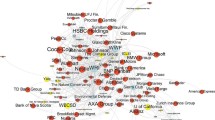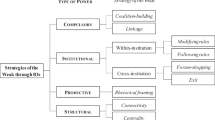Abstract
It is widely presumed that preventing or addressing widespread corruption requires effective public institutions, supplemented by non-state actors, in a system of interlocking and interlinked institutions and actors (anti-corruption checks and balances). However there has been little evidence of the interactions and interdependencies between anticorruption mechanisms to enable empirical testing of theories that such institutionalised networks function as such, or have any relationship with reduced corruption. We use assessments of the performance of accountability roles of a diversity of institutions, on 19 indicators, in 38 countries using the National Integrity System approach, to test for the relationships between horizontal and vertical accountability, and the importance of each – and accountability in general – for policy and institutional reforms aimed at curbing corruption. We show that horizontal and vertical accountability are each measurable constructs, whose weakness or strength does tend to correlate; and that while causation is beyond the scope of this analysis, this accountability role performance also correlates separately and jointly with independent measures of corruption control. These results affirm the potential for holistic, country-based qualitative assessments of networked integrity institutions, as pioneered by the NIS approach, to deliver stronger evidence of how reforms to prevent and suppress corruption can be better targeted.


Similar content being viewed by others
References
Adcock, R., & Collier, D. (2001). Measurement Validity: A Shared Standard for Qualitative and Quantitative Research, the American Political Review. The International Journal of Social Economics, 33(1), 529–546.
Alt, J. E., & Lassen, D. D. (2008). Political and judicial checks on corruption: Evidence from American state governments. Economics and Politics, 20(1), 33–61.
Bågenholm, A. (2013). Throwing the rascals out? The electoral effects of corruption allegations and corruption scandals in Europe 1981–2011. Crime, Law and Social Change, 60(5), 595–609.
Beth-Seo, E., & De Jaegere, S. (2014). Anti-corruption strategies. Understanding what works, what Doesn’t and why. Lessons learned from the Asia-Pacific region. New York: UNDP.
Botero, J. C., & Ponce, A. (2011). Measuring the rule of law. Available at SSRN 1966257.
Brown, A. J. (2006). ‘What are we trying to measure? Reviewing the basics of corruption definition' in C. Sampford, A. Shacklock, F. Galtung, & C. Connors (eds), Measuring Corruption, Ashgate, UK.
Brunetti, A., & Weder, B. (2003). A free press is bad news for corruption. Journal of Public Economics, 87(7), 1801–1824.
Bukanovsky, M. (2006). The hollowness of anti-corruption discourse. Review of International Political Economy, 13(2), 181–209.
Camaj, L. (2013). The media’s role in fighting corruption: Media effects on governmental accountability. The International Journal of Press/Politics, 18, 21–42.
Chene, M. (2015). Accountability and corruption. A literature review. U4 Helpdesk answer. Berlin: Transparency international. http://www.Transparency.Org/files/content/corruptionqas/Links_between_accountability_and_corruption.Pd accessed 20. May, 2016.
Disch, A., Vigeland, E., & Sundet, G. (2009). Anti-corruption approaches: A literature review. Oslo: Norwegian Agency for Development Cooperation http://www.norad.no/en/toolspublications/publications/2009/anti-corruption-approaches-a-literature-review/.
Eggers, A. C., & Fisher, A. C. (2011). Electoral accountability and the UK parliamentary expenses scandal: Did voters punish corrupt MPs?. Available at SSRN 1931868.
Fish, M., et al. (2015). Legislative powers and executive corruption. In V-Dem Working Paper Series 2015: 7. Gothenburg: University of Gothenburg.
Fox, J. A. (2015). Social accountability: What does the evidence really say? World Development, 72, 346–361.
Frangonikolopoulos, C. A. (2014). Politics, the media and NGOs: The Greek experience. Perspectives on European Politics and Society, 15(4), 606–619.
Global Integrity. (2011). The global integrity report: 2011 methodology white paper. http://www.globalintegrity.org/wp-content/uploads/2013/08/2011_GIR_Meth_Whitepaper.pdf. Last accessed 6 Sept 2014.
Gloppen, S., Gargarella, R., & Skaar, E. (Eds.). (2004). Democratization and the Judciary: The accountability function of courts in new democracies. London: Frank Cass.
Goetz, A. M., & Jenkins, R. (2001). Hybrid forms of accountability: Citizen engagement in institutions of public-sector oversight in India. Public Management Review, 3(3), 363–383. https://doi.org/10.1080/14616670110051957.
Hulsey, J. (2015). Party politics in Bosnia and Herzegovina. In S. Keil & P. Perry (Eds.), State-building and democratization in Bosnia and Herzegovina (pp. 41–60). London: Ashgate.
Hussmann, K. (2007). Anti-corruption policy-making in practice: What can we learn from the implementation of article 5 of UNCAC? U4 Report 1: 2007. Bergen: U4.
ICAC. (2014). Election funding, expenditure and disclosure in new South Wales: Strengthening transparency and accountability. Sydney: Independent Commission Against Corruption.
Johnson, J., Taxell, N. & Zaum, D. (2012). Mapping evidence gaps in anti-corruption: Assessing the state of the operationally relevant evidence on donors' actions and approaches to reducing corruption. Bergen: Chr. Michelsen institute (U4 issue 2012:7).
Joshi, A. (2013). Do they work? Assessing the impact of transparency and accountability initiatives in service delivery. Development Policy Review, 31(1), 29–48.
Kaufmann, D., & Kraay, A. (2007). On measuring governance: Framing issues for debate. Munich personal RePEc archive, MPRA paper no. 8187. http://mpra.ub.uni-muenchen.de/8187.
Kaufmann, D., Kraay, A., & Mastruzzi, M. (2011). The worldwide governance indicators: Methodology and analytical issues. Hague Journal on the Rule of Law, 3(2), 220–246.
Kenney, C. D. (2003). Horizontal accountability: Concepts and conflicts. In S. Mainwaring & C. Welna (Eds.), Democratic accountability in Latin America (pp. 55–76). Oxford: Oxford University Press.
Klitgaard, R. (1988). Controlling corruption. Berkeley: University of California Press.
La Porta, R., Lopez-de-Silanes, F., Pop-Eleches, C., & Shleifer, A. (2004). Judicial checks and balances. Journal of Political Economy, 112, 445–470.
Malena, C. (2009). From political won't to political will: Building support for participatory governance. Sterling: Kumarian Press.
McGee, R. (2010). Synthesis report: Review of impact and effectiveness of transparency and accountability initiatives. Available at SSRN 2188139.
McNeil, M., & Malena, C. (2010). Demanding good governance : Lessons from social accountability initiatives in Africa. Washington, D.C.: World Bank.
Mulcahy, S. (2012). Money, power, politics. Corruption risks in Europe. Transparency International: Berlin.
Mungiu-Pippidi, A. (2011) Contextual choices in fighting corruption: Lessons learned. NORAD, report 4/2011. Available at www.norad.no/en/tools-and-publications/publications/publication?key=383808.
Mungiu-Pippidi, A. (2017). The time has come for evidence-based anticorruption. Nature Human Behaviour, 1, Article No. 0011. https://doi.org/10.1038/s41562-016-0011.
Norris, P., & Abel van Es, A. (2016). Checkbook elections, Political Finance in Comparative Perspective. Oxford: Oxford University Press.
O’Donnell, G. (1999a). Horizontal accountability in new democracies. In A. Schedler, L. Diamond, & M. F. Plattner (Eds.), The self-restraining state: power and accountability in new democracies (pp. 29–51). Boulder: Lynne Rienner Publishers.
O’Donnell, G. (1999b). A response to my commentators. In A. Schedler, L. Diamond, & M. F. Plattner (Eds.), The self-restraining state: Power and accountability in new democracies (pp. 68–71). Boulder: Lynne Rienner Publishers.
O’Donnell, G. (2003). Horizontal accountability. The legal institutionalization of mistrust. In S. Mainwaring & C. Welna (Eds.), Democratic accountability in Latin America (pp. 34–54). Oxford: Oxford University Press.
Olken, B. A. (2006). Corruption and the costs of redistribution: Micro evidence from Indonesia. Journal of Public Economics, 90(4), 853–870.
Persson, A., Rothstein, B., & Teorell, J. (2013). Why anticorruption reforms fail--systemic corruption as a collective action problem. Governance, 26(3), 449–471.
Przeworski, A., & Stokes, S. C. (1999). Democracy, accountability, and representation (Vol. 2). New York: Cambridge University Press.
Pope, J. (2000). TI sourcebook (Second ed.). Berlin: Transparency International.
Rose-Ackerman, S. (2005). From elections to democracy: Building accountable government in Hungary and Poland. Cambridge: Cambridge University Press.
Sampford, C., Smith, R., & Brown, A. J. (2005). From Greek temple to Bird’s Nest: Towards a theory of coherence and mutual accountability for National Integrity Systems. Australian Journal of Public Administration, 64(2), 96–108.
Schacter, M. (2005). A framework for evaluating institutions of accountability. Fiscal Management, 229–245.
Schatz, F. (2013). Fighting corruption with social accountability: A comparative analysis of social accountability mechanisms’ potential to reduce corruption in public administration. Public Administration and Development, 33, 161–174.
Schmitter, P. (1999). The limits of horizontal accountability. In A. Schedler, L. Diamond, & M. F. Plattner (Eds.), The self-restraining state: Power and accountability in new democracies (pp. 59–62). Boulder: Lynne Rienner Publishers.
SELDI. (2014). Anti-corruption reloaded. Assessment of Southeast Europe. Sofia: Centre for Study of Democracy.
Six, F., & Lawton, A. (2013). Towards a theory of integrity systems: A configurational approach. International Review of Administrative Sciences, 79(4), 639–658.
Smulovitz, C., & Peruzzotti, E. (2003). Societal and horizontal controls. Two cases of a fruitful relationship. In S. Mainwaring & C. Welna (Eds.), Democratic accountability in Latin America (pp. 309–331). Oxford: Oxford University Press.
Sotiropoulos, D. A. (2014). Civil Society in Greece in the wake of the economic crisis. Athens: Konrad-Adenauer Foundation.
Transparency International Bosnia & Herzegovina. (2013). National integrity system assessment Bosnia & Herzegovina. Banja Luka: TI Bosnia & Herzegovina.
vaz Mondo, B. (2015). Accountability as a deterrent to corruption: New data from Brazilian municipalities. European Consortium of Political Research Joint Sessions - Warsaw, 29 March-2 April 2015. http://ecpr.eu/Filestore/PaperProposal/c19b9e1c-406c-476a-aef0-37054ce559e9.pdf.
World Justice Project. (2015). WJP rule of law index. Constraints on Government Powers. http://worldjusticeproject.org/factors/constraints-government-powers. Last accessed 7 Sept 2015.
Mungiu-Pippidi, A. & Dadašov, R. (2017). When do anticorruption laws matter? The evidence on public integrity enabling contexts. Crime Law & Social Change. https://doi.org/10.1007/s10611-017-9693-3.
Peiffer, C. & Marquette, H. (2015). Theoretical (Mis)understanding? Applying principal-agent and collective action theories to the problem of corruption in systemically corrupt countries. In A. Lawton, Z. van der Wal & L. Huberts (Eds.), Ethics in public policy and management: a global research companion (pp. 109–126). Oxford & New York: Routledge.
Author information
Authors and Affiliations
Corresponding author
Annex
Annex
Rights and permissions
About this article
Cite this article
Heinrich, F., Brown, A.J. Measuring accountability performance and its relevance for anti-corruption: introducing a new integrity system-based measure. Crime Law Soc Change 68, 359–381 (2017). https://doi.org/10.1007/s10611-017-9712-4
Published:
Issue Date:
DOI: https://doi.org/10.1007/s10611-017-9712-4




